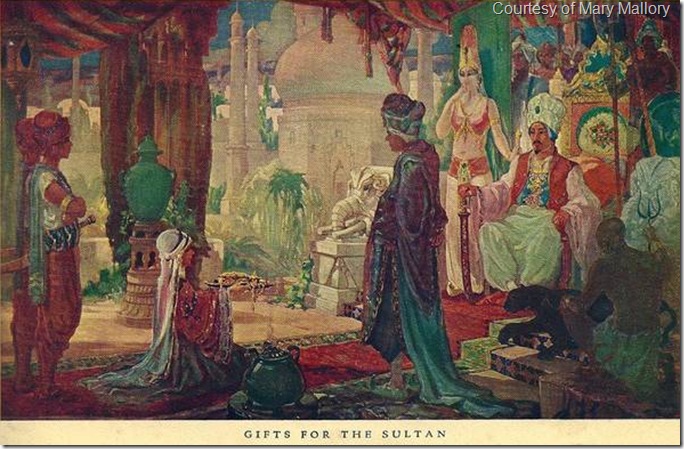
One of Einar Petersen’s murals at the Spring Street Guaranty Building and Loan Assn., courtesy of Mary Mallory
Fame is fleeting. An individual might go unrecognized while creating great art while alive, only for the works to be considered masterpieces decades after their death, as with painter Vincent Van Gogh. Others slowly build a portfolio of work, gaining increasing recognition and respect with each new piece. They maintain fame for a long while, but see it disappear as times, styles and values change. Many become forgotten.
Unfortunately, this second scenario applies to Einar C. Petersen, recognized as one of Los Angeles’ and California’s greatest muralists in the 1920s. Achieving great reviews for his first Los Angeles mural at the New Rosslyn Hotel in 1915, Petersen would go on to craft murals for San Francisco’s Hunter-Dulin Building as well as downtown’s Mayflower Hotel, Beverly Hills Security-National Bank, and particularly, the forest mural for Clifton’s Cafeteria on Broadway Street in downtown Los Angeles. As new owners and developers came along, most either removed or painted over Petersen’s murals, save for the one in Clifton’s.
Mary Mallory’s “Hollywoodland: Tales Lost and Found” for the Kindle is available from Amazon.
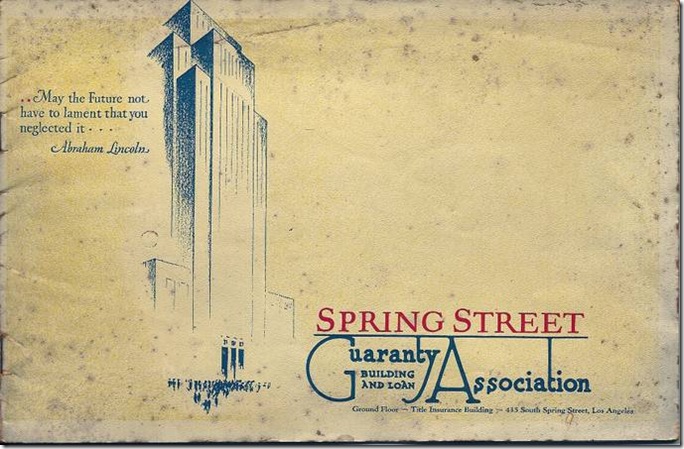
Spring Street Guaranty Building and Loan Assn. at 435 Spring St. commissioned him in 1928 to create murals for the lobby and one for its conference room titled “Aladdin and His Lamp.” It intended the murals to extol the wonders of saving with them, and the riches it would bestow.
The organization had been formed by Hollywood native Gilbert Beesemyer, developer of Hollywood and Vine, and controlling secretary of Hollywood’s Guaranty Building and Loan Assn. He bought and used the charter of Vermont Building and Loan Assn. to establish Spring Street in late summer 1928. It was renovating the ground floor of the Title Insurance Building on Spring Street as its offices for a September opening.
Their Sept. 13, 1928, ad in the Los Angeles Times featured the lobby with drawings of Petersen’s murals prominently displayed on the walls, acknowledging his creation of the murals, and inviting the public to the grand opening.
The Times review of the building that day described a lovely Art Deco office, which was stylish, and emphasized Petersen’s glorious murals. “Construction and decoration of the new offices are a departure from the usual style. The principal color scheme is silver and black, while paintings and panels depicting the life of Aladdin adorn the walls. A specially designed lighting system throws consistently changing colors over the paintings.”
To help promote both themselves and the murals, the company created a 10-page brochure with color illustrations of the lobby murals. While it declared the story of Aladdin and his lamp a myth, it announced that, “The Magic of Building and Loan is a very real, material thing.” Investing money and getting mortgages with the company would bring success to those participants, as well as a haven for their money.
The booklet opened with the foreword stating, “We are indeed grateful for the praise and admiration which the citizens of Los Angeles have expressed for our new quarters in the magnificent Title Insurance Building, even in advance of their completion.
“In the firm belief that the days are gone when a cold, forbidding aspect can any longer be considered an essential qualification for the offices of financial institutions, we have tried to combine beauty and warmth with utmost utility and a really friendly, helpful, capable spirit of service.
“This little booklet has been prepared in response to hundreds of requests for copies of the beautiful ‘Aladdin and His Lamp’ murals which are the principal decorative feature of our offices, and to the unmistakable indication that there are literally thousands who would like to know more about Building and Loan as exemplified by the Spring Street Guaranty Building and Loan Assn.
“It is our earnest hope that it will both please and interest you.”
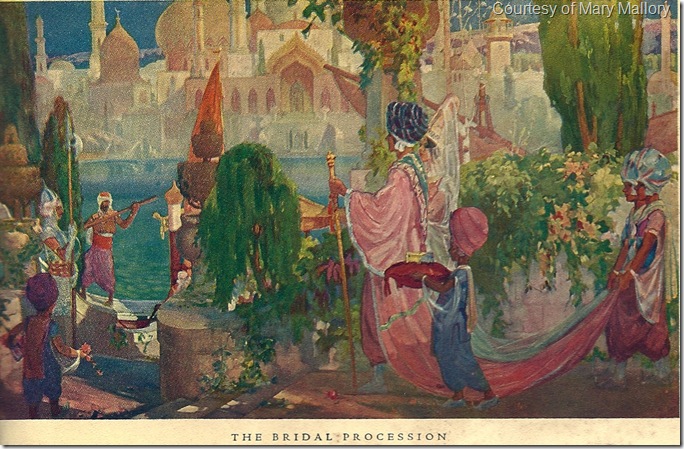
One of Einar Petersen’s murals at the Spring Street Guaranty Building and Loan Assn, courtesy of Mary Mallory.
Page 3 of the brochure gave the story of the murals. “…The Story of Aladdin, which was chosen as the theme of the 10 mural paintings and panels on the walls of our Title Insurance Building offices, shows us first, an indolent, wastrel boy who falls into the hands of a magician, and is tempted by the tales told him of riches without effort. Next, we see him in the Sorcerer’s Cave, with the Lamp, surrounded by untold wealth. How he discovers the secret of the Ring and the Lamp are known to almost all. Even with their magic power at his disposal, the age-old traits of frugality and economy manifest themselves, and he sells the silver dishes in which the Genii brings his food, exhausting the money thus obtained before again calling upon his magic talisman.
“…Happy as is the final outcome of the Tale, it carries a forceful illustration to we moderns of the precariousness of wealth, position, and success obtained solely through good fortune. The loss of his priceless Lamp, his Palace, his Princess, his own life, almost; are such incidents.
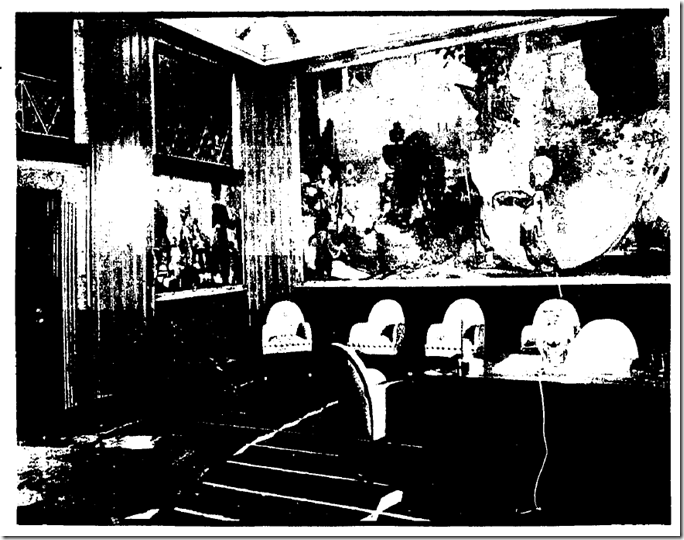
‘Indeed, ‘Aladdin and His Lamp,’ as executed for the Spring Street Guaranty Building and Loan Assn. by Einar Petersen, famed Los Angeles artist, shows the futility of ‘trusting to luck,’ in a most vivid and beautiful way. And the Spring Street Guaranty Building and Loan Assn. is proud to have had the privilege of adding these colorful paintings to the art treasures of Los Angeles, and California.”
The Times would go on to feature photos of some of the murals in the Sept. 16 and Dec. 2, 1928, papers. Bessemyer would help greet Santa Claus for the Hollywood Boulevard Assn.’s Santa Claus Lane that December as well.
Spring Street was riding high. It merged with Beesemyer’s Hollywood Guaranty Building and Loan Assn. on Dec. 25, 1928, only 60 days after forming. It was affiliated with the U. S. Guarantee Corp., with assets of $25 million, with Beesemyer as president.
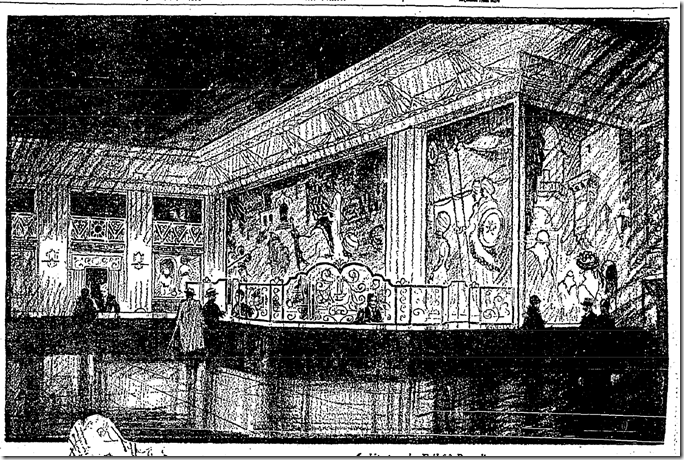
Unfortunately, Beesemyer was following the early practices of the wastrel Aladdin, and employing the funds of the two organizations as a piggy bank. In December 1930, the Hollywood Guaranty Building and Loan Assn. collapsed, with Beesemyer admitting to illegal actions after auditors found that $8 million was missing.
Beesemyer pleaded guilty Dec. 13, 1930, with his trial occurring early in 1931. Creditors discovered that half of the losses came from theft, and half through bad investments on Beesemyer’s part, especially in oil wells that kept coming up dry. Bessemyer admitted to buying land with the association’s money, putting the title in his name and hiding the deficit in the accounts, while never covering the overdrafts, with lax auditing by the state helping prolong the disaster. What was worse, some employees knew of his illegal actions, but turned the other way.
The court found Beesemyer guilty, giving him a 40-year sentence, in which he had to serve at least 13 years. He was sent to San Quentin as convict No. 1947155, after willingly turning over all property to help depositors who had suffered losses, and filed for personal bankruptcy.
It took almost five years to resolve matters with Guaranty, with creditors finally receiving 25% on the dollar. Even more troubling to investors was the fact that the state considered Beesemyer a model prisoner in his accounting job in the prison commissary, granting him an immediate parole on Aug. 4, 1939, after protests and hearings from the public. After serving only eight years, Beesemyer was free to leave the state, moving to Chicago for a job. He disappeared from the papers.
Spring Street Guaranty Building and Loan Assn. also closed in December 1930 because of its connection to Beesemyer, sitting empty for a time. L. L. Elliott Co., an investment firm, operated there in 1934, before being replaced by Mitchell Brown and Co., another investment firm, in 1935. The address is not mentioned again until the lobby became a Christian Science reading room in 1944, lasting at least through 1953, when the location again disappears from papers.
What became of the murals? Were they removed during all the upheavals, or did they survive until recently? I toured the building in April 2012, discovering that the lobby of 435 S. Spring St. echoes that of the New Rosslyn Building just a block away, containing blank beige walls. In July 2013, one panel of the New Rosslyn murals came up for sale on eBay, so perhaps these lovely Aladdin murals rest someplace, and will magically reappear one day, to testify to the talent of the virtually forgotten Petersen.


Petersen’s murals would make an excellent large format coffee table book, screensavers, etc. if they are found. The Hawaiian murals in Damon’s Steak House in Glendale, CA are available on consumer products. PS On a different artistic level, what happened to the [rather racist] murals in the old Sambo’s coffee shops? Sambo was changed from black to vaguely Middle Eastern, then the chain folded. Most were mosaic, and probably destroyed.
LikeLike